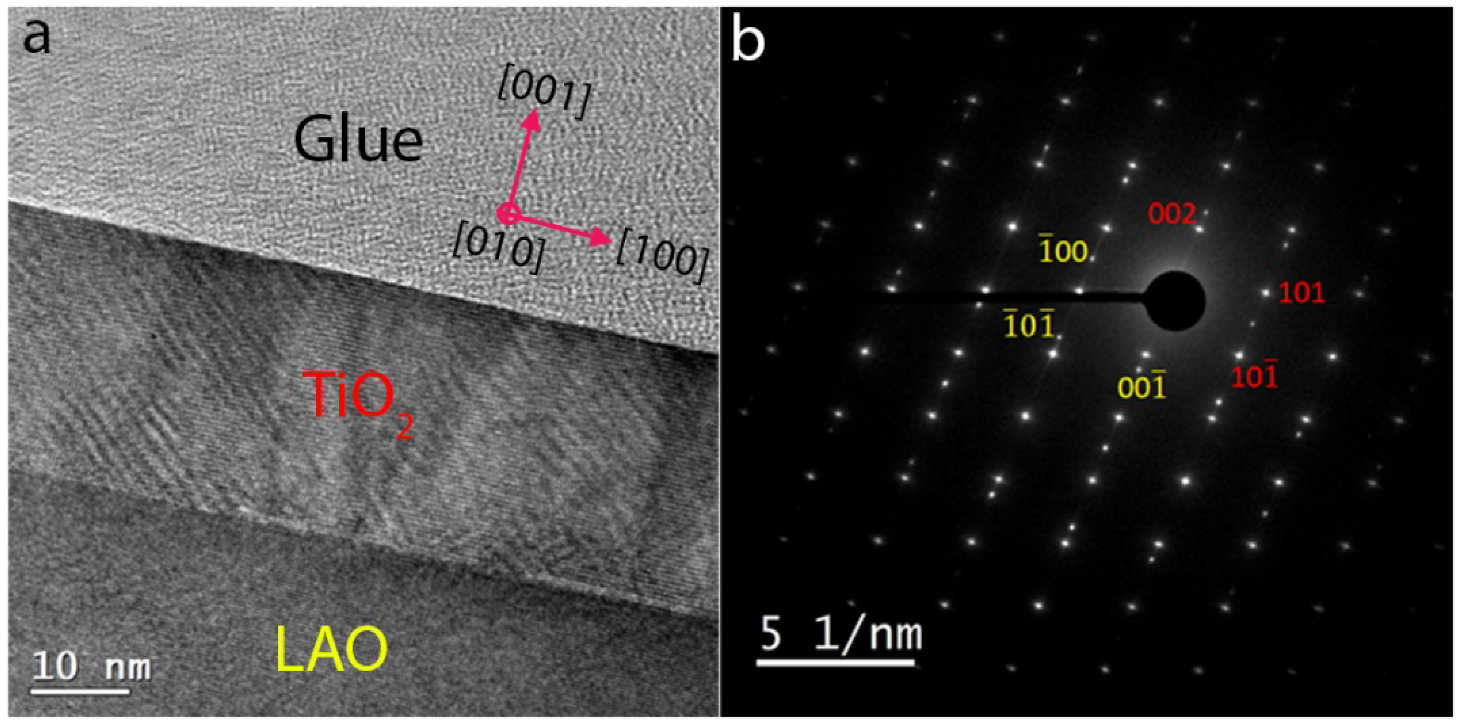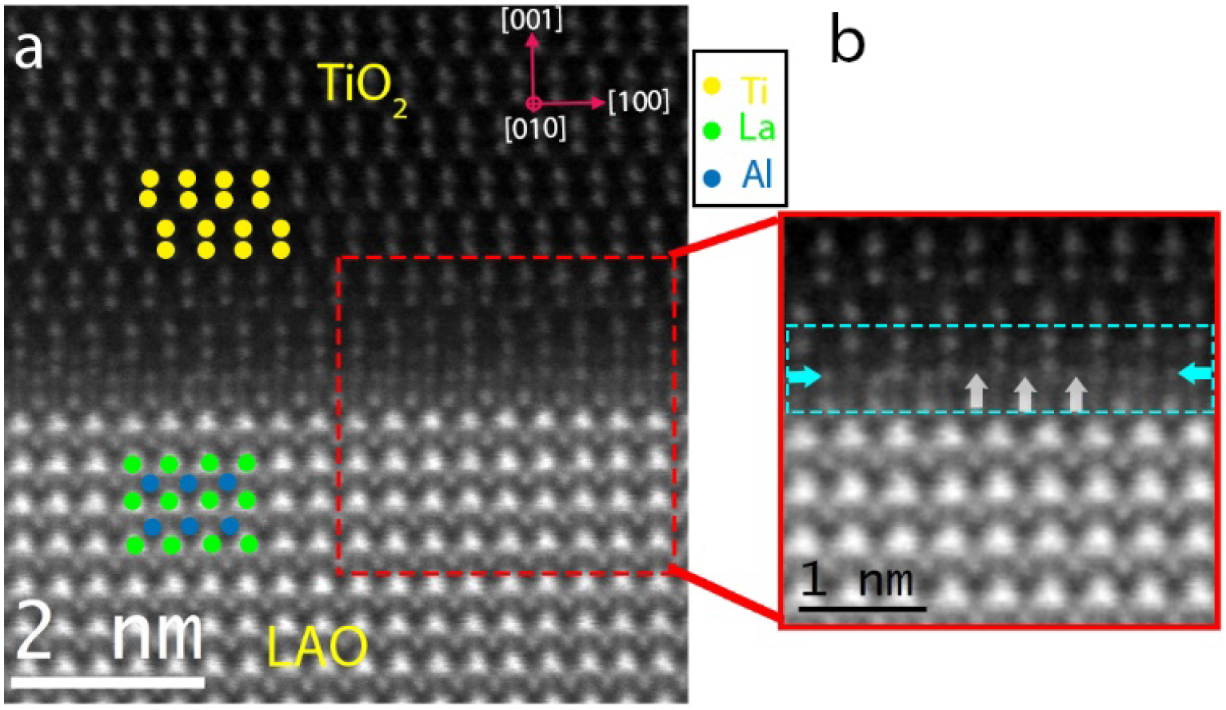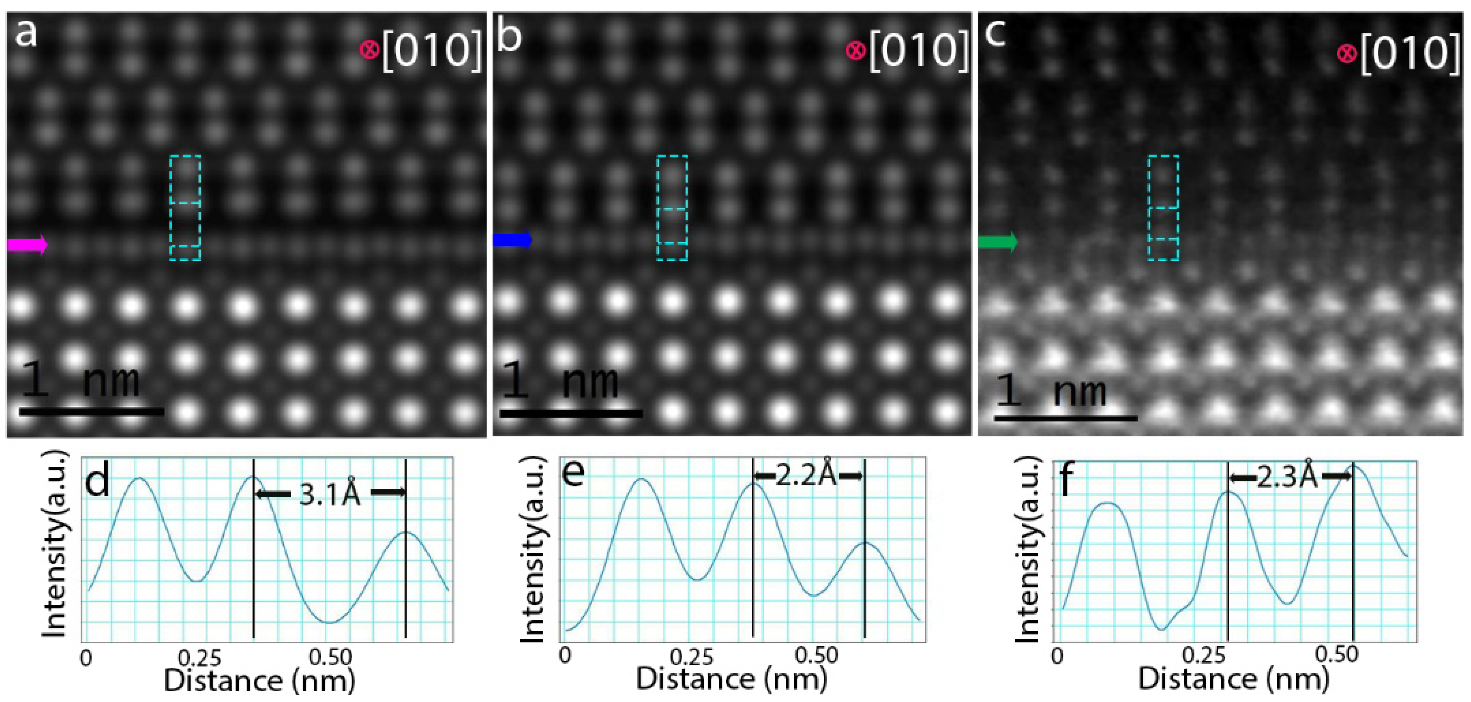HAADF STEM and Ab Initio Calculations Investigation of Anatase TiO2/LaAlO3 Heterointerface
Abstract
:1. Introduction
2. Materials and Methods
2.1. Thin-Film Growth
2.2. HRTEM and HAADF STEM Experiments
2.3. DFT Calculations
2.4. STEM-HAADF Image Simulation
3. Results and Discussions
4. Conclusions
Author Contributions
Funding
Institutional Review Board Statement
Informed Consent Statement
Data Availability Statement
Acknowledgments
Conflicts of Interest
References
- Ohtomo, A.; Hwang, H.Y. A high-mobility electron gas at the LaAlO3/SrTiO3 heterointerface. Nature 2004, 427, 423–427. [Google Scholar] [CrossRef] [PubMed]
- Savoia, A.; Paparo, D.; Perna, P.; Ristic, Z.; Salluzzo, M.; Granozio, F.M.; Scotti di Uccio, U.; Richter, C.; Thiel, S.; Mannhart, J.; et al. Polar catastrophe and electronic reconstructions at the LaAlO3/SrTiO3 interface: Evidence from optical second-harmonic generation. Phys. Rev. B 2009, 80, 075110. [Google Scholar] [CrossRef] [Green Version]
- Brinkman, A.; Huijben, M.; Van Zalk, M.; Zeitler, U.; Maan, J.C.; van der Wiel, W.; Rijnders, G.; Blank, D.H.A.; Hilgenkamp, H. Magnetic effects at the interface between non-magnetic oxides. Nat. Mater. 2007, 6, 493–496. [Google Scholar] [CrossRef] [PubMed]
- Bi, F.; Huang, M.; Ryu, S.; Lee, H.; Bark, C.W.; Eom, C.B.; Irvin, P.; Levy, J. Room-temperature electronically-controlled ferromagnetism at the LaAlO3 /SrTiO3 interface. Nat. Commun. 2014, 5, 5019. [Google Scholar] [CrossRef] [PubMed] [Green Version]
- Adamo, C.; Perroni, C.A.; Cataudella, V.; De Filippis, G.; Orgiani, P.; Maritato, L. Tuning the metal-insulator transitions of (SrMnO3)n/(LaMnO3)2n superlattices: Role of interfaces. Phys. Rev. B 2009, 79, 045125. [Google Scholar] [CrossRef]
- Coll, M.; Fontcuberta, J.; Althammer, M.; Bibes, M.; Boschker, H.; Calleja, A.; Cheng, G.; Cuoco, M.; Dittmann, R.; Dkhil, B.; et al. Towards Oxide Electronics: A Roadmap. Appl. Surf. Sci. 2019, 482, 1–93. [Google Scholar] [CrossRef]
- Thiel, S.; Hammerl, G.; Schmehl, A.; Schneider, C.W.; Mannhart, J. Tunable Quasi-Two-Dimensional Electron Gases in Oxide Heterostructures. Science 2006, 313, 1942–1945. [Google Scholar] [CrossRef]
- Reinle-Schmitt, M.; Cancellieri, C.; Li, D.; Fontaine, D.; Medarde, M.; Pomjakushina, E.; Schneider, C.; Gariglio, S.; Ghosez, P.; Triscone, J.-M.; et al. Tunable conductivity threshold at polar oxide interfaces. Nat. Commun. 2012, 3, 932. [Google Scholar] [CrossRef] [Green Version]
- Kalabukhov, A.; Gunnarsson, R.; Börjesson, J.; Olsson, E.; Claeson, T.; Winkler, D. Effect of oxygen vacancies in the SrTiO3 substrate on the electrical properties of the LaAlO3/SrTiO3 interface. Phys. Rev. B. 2007, 75, 121404. [Google Scholar] [CrossRef] [Green Version]
- Slooten, E.; Zhong, Z.; Molegraaf, H.J.A.; Eerkes, P.D.; De Jong, S.; Massee, F.; van Heumen, E.; Kruize, M.K.; Wenderich, S.; Kleibeuker, J.E.; et al. Hard X-ray photoemission and density functional theory study of the internal electric field in SrTiO3/LaAlO3 oxide heterostructures. Phys. Rev. B 2013, 87, 085128. [Google Scholar] [CrossRef] [Green Version]
- Liu, Z.Q.; Li, C.J.; Lü, W.M.; Huang, X.H.; Huang, Z.; Zeng, S.W.; Qiu, X.P.; Huang, L.S.; Annadi, A.; Chen, J.S.; et al. Origin of the Two-Dimensional Electron Gas at LaAlO3/SrTiO3 Interfaces: The Role of Oxygen Vacancies and Electronic Reconstruction. Phys. Rev. X 2013, 3, 021010. [Google Scholar]
- Moser, S.; Moreschini, L.; Jaćimović, J.; Barišić, O.S.; Berger, H.; Magrez, A.; Chang, Y.J.; Kim, K.S.; Bostwick, A.; Rotenberg, E.; et al. Tunable polaronic conduction in anatase TiO2. Phys. Rev. Lett. 2013, 110, 196403. [Google Scholar] [CrossRef] [PubMed] [Green Version]
- Rödel, T.C.; Fortuna, F.; Bertran, F.; Gabay, M.; Rozenberg, M.J.; Santander-Syro, A.F.; Le Fèvre, P. Engineering two-dimensional electron gases at the (001) and (101) surfaces of TiO2 anatase using light. Phys. Rev. B 2015, 92, 041106. [Google Scholar] [CrossRef] [Green Version]
- Wang, Z.; Zhong, Z.; Walker, S.M.; Ristic, Z.; Ma, J.; Bruno, F.Y.; Riccò, S.; SanGiovanni, G.; Eres, G.; Plumb, N.C.; et al. Atomically Precise Lateral Modulation of a Two-Dimensional Electron Liquid in Anatase TiO2 Thin Films. Nano Lett. 2017, 17, 2561–2567. [Google Scholar] [CrossRef] [Green Version]
- Ma, X.; Cheng, Z.; Tian, M.; Liu, X.; Cui, X.; Huang, Y.; Tan, S.; Yang, J.; Wang, B. Formation of Plasmonic Polarons in Highly Electron-Doped Anatase TiO2. Nano Lett. 2020, 21, 430–436. [Google Scholar] [CrossRef]
- Troglia, G.P.A.; Bigi, C.; Vobornik, I.; Fujii, J.; Knez, D.; Ciancio, R.; Drazic, G.; Fuchs, M.; Di Sante, D.; Sangiovanni, G.; et al. Evidence of a two-dimensional electron gas in a single-unit-cell of anatase TiO2 (001). Adv. Sci. 2021; in press. [Google Scholar]
- Knez, D.; Dražić, G.; Chaluvadi, S.K.; Orgiani, P.; Fabris, S.; Panaccione, G.; Rossi, G.; Ciancio, R. Unveiling Oxygen Vacancy Superstructures in Reduced Anatase Thin Films. Nano Lett. 2020, 20, 6444–6451. [Google Scholar] [CrossRef]
- Rossi, G.; Ciancio, R.; Africh, C.; Gotter, R.; Panaccione, G.; Ferranti, R. NFFA, Nanoscience Foundries & Fine Analysis (NFFA)—Trieste. IRIS 2011, 16, 8–12. [Google Scholar]
- Chaluvadi, S.K.; Mondal, D.; Bigi, C.; Knez, D.; Rajak, P.; Ciancio, R.; Fujii, J.; Panaccione, G.; Vobornik, I.; Rossi, G.; et al. Pulsed laser deposition of oxide and metallic thin films by means of Nd:YAG laser source operating at its 1st harmonics: Recent approaches and advances. J. Phys. Mater. 2021, 4, 032001. [Google Scholar] [CrossRef]
- Panaccione, G.; Vobornik, I.; Fujii, J.; Krizmancic, D.; Annese, E.; Giovanelli, L.; Maccherozzi, F.; Salvador, F.; De Luisa, A.; Benedetti, D.; et al. Advanced photoelectric effect experiment beamline at Elettra: A surface science laboratory coupled with Synchrotron Radiation. Rev. Sci. Instrum. 2009, 80, 043105. [Google Scholar] [CrossRef] [Green Version]
- Bigi, C.; Tang, Z.; Pierantozzi, G.M.; Orgiani, P.; Das, P.P.K.; Fujii, J.; Vobornik, I.; Pincelli, T.; Troglia, A.; Lee, T.L.; et al. Distinct behavior of localized and delocalized carriers in anatase TiO2 (001) during reaction with O2. Phys. Rev. Mater. 2020, 4, 025801. [Google Scholar] [CrossRef] [Green Version]
- Gobaut, B.; Orgiani, P.; Sambri, A.; Di Gennaro, E.; Aruta, C.; Borgatti, F.; Lollobrigida, V.; Céolin, D.; Rueff, J.-P.; Ciancio, R.; et al. Role of Oxygen Deposition Pressure in the Formation of Ti Defect States in TiO2(001) Anatase Thin Films. ACS Appl. Mater. Interfaces 2017, 9, 23099–23106. [Google Scholar] [CrossRef] [PubMed] [Green Version]
- Orgiani, P.; Perucchi, A.; Knez, D.; Ciancio, R.; Bigi, C.; Chaluvadi, S.K.; Fujii, J.; Vobornik, I.; Panaccione, G.; Rossi, G.; et al. Tuning the Optical Absorption of Anatase Thin Films across the Visible-To-Near-Infrared Spectral Region. Phys. Rev. Appl. 2020, 13, 044011. [Google Scholar] [CrossRef]
- Giannozzi, P.; Baroni, S.; Bonini, N.; Calandra, M.; Car, R.; Cavazzoni, C.; Ceresoli, D.; Chiarotti, G.L.; Cococcioni, M.; Dabo, I.; et al. QUANTUM ESPRESSO: A modular and open-source software project for quantum simulations of materials. J. Phys. Condens. Matter Inst. Phys. J. 2009, 21, 395502. [Google Scholar] [CrossRef] [PubMed]
- Haas, P.; Tran, F.; Blaha, P. Calculation of the lattice constant of solids with semilocal functionals. Phys. Rev. B 2009, 79, 085104. [Google Scholar] [CrossRef] [Green Version]
- Koch, C.T. Determination of Core Structure Periodicity and Point Defect Density along Dislocations. Ph.D. Thesis, Arizona State University, Phoenix, AZ, USA, 2002. [Google Scholar]
- Ciancio, R.; Carlino, E.; Aruta, C.; Maccariello, D.; Granozio, F.M.; di Uccio, U.S. Nanostructure of buried interface layers in TiO2anatase thin films grown on LaAlO3 and SrTiO3 substrates. Nanoscale 2011, 4, 91–94. [Google Scholar] [CrossRef]
- Ciancio, R.; Carlino, E.; Rossi, G.; Aruta, C.; Di Uccio, U.S.; Vittadini, A.; Selloni, A. Magnéli-like phases in epitaxial anatase TiO2 thin films. Phys. Rev. B 2012, 86, 104110. [Google Scholar] [CrossRef] [Green Version]
- Howie, A. Image Contrast and Localized Signal Selection Techniques. J. Microsc. 1979, 117, 11–23. [Google Scholar] [CrossRef]
- Kirkland, E.J.; Loane, R.F.; Silcox, J. Simulation of annular dark field stem images using a modified multislice method. Ultramicroscopy 1987, 23, 77–96. [Google Scholar] [CrossRef]
- Kirkland, E.J. Advanced Computing in Electron Microscopy; Plenum Press: New York, NY, USA, 1998. [Google Scholar]
- Wang, Z.; Zeng, W.; Gu, L.; Saito, M.; Tsukimoto, S.; Ikuhara, Y. Atomic-scale structure and electronic property of the LaAlO3/TiO2 interface Atomic-scale structure and electronic property of the LaAlO3/TiO2 interface. J. Appl. Phys. 2014, 108, 113701–113709. [Google Scholar] [CrossRef]
- Zheng, S.; Fisher, C.A.J.; Kato, T.; Nagao, Y.; Ohta, H.; Ikuhara, Y. Domain formation in anatase TiO2 thin films on LaAlO3 substrates. Appl. Phys. Lett. 2012, 101, 191602. [Google Scholar] [CrossRef]
- Jain, A.; Ong, S.P.; Hautier, G.; Chen, W.; Richards, W.D.; Dacek, S.; Cholia, S.; Gunter, D.; Skinner, D.; Ceder, G.; et al. Commentary: The Materials Project: A materials genome approach to accelerating materials innovation. APL Mater. 2013, 1, 011002. [Google Scholar] [CrossRef] [Green Version]





Publisher’s Note: MDPI stays neutral with regard to jurisdictional claims in published maps and institutional affiliations. |
© 2022 by the authors. Licensee MDPI, Basel, Switzerland. This article is an open access article distributed under the terms and conditions of the Creative Commons Attribution (CC BY) license (https://creativecommons.org/licenses/by/4.0/).
Share and Cite
Islam, M.; Rajak, P.; Knez, D.; Chaluvadi, S.K.; Orgiani, P.; Rossi, G.; Dražić, G.; Ciancio, R. HAADF STEM and Ab Initio Calculations Investigation of Anatase TiO2/LaAlO3 Heterointerface. Appl. Sci. 2022, 12, 1489. https://doi.org/10.3390/app12031489
Islam M, Rajak P, Knez D, Chaluvadi SK, Orgiani P, Rossi G, Dražić G, Ciancio R. HAADF STEM and Ab Initio Calculations Investigation of Anatase TiO2/LaAlO3 Heterointerface. Applied Sciences. 2022; 12(3):1489. https://doi.org/10.3390/app12031489
Chicago/Turabian StyleIslam, Mahabul, Piu Rajak, Daniel Knez, Sandeep Kumar Chaluvadi, Pasquale Orgiani, Giorgio Rossi, Goran Dražić, and Regina Ciancio. 2022. "HAADF STEM and Ab Initio Calculations Investigation of Anatase TiO2/LaAlO3 Heterointerface" Applied Sciences 12, no. 3: 1489. https://doi.org/10.3390/app12031489
APA StyleIslam, M., Rajak, P., Knez, D., Chaluvadi, S. K., Orgiani, P., Rossi, G., Dražić, G., & Ciancio, R. (2022). HAADF STEM and Ab Initio Calculations Investigation of Anatase TiO2/LaAlO3 Heterointerface. Applied Sciences, 12(3), 1489. https://doi.org/10.3390/app12031489










